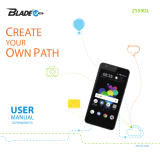
19
Personalizing
Using Do Not Disturb Mode
You can limit interruptions with Do not disturb mode. This mode
silences your phone so that it doesn‟t make sounds or vibrate
when you don‟t want it to.
To turn on Do not disturb mode:
1. Touch the Home key > Settings > All settings > Sounds &
vibration > Do not disturb > Do not disturb.
2. Touch Always or Scheduled as you need.
Touch Always to turn on the Do not disturb feature
immediately, which keeps on until you turn it off.
Touch Scheduled if you want the feature turned on and
off automatically during specific periods.
3. If you select Scheduled, touch Days, Start time, and End
time to specify the periods during which Do not disturb is on.
To set exceptions for Do not disturb mode:
You can set reminders, certain calls and messages as exceptions
when Do not disturb mode is on, so these ringtones, sounds and
vibration are not turned off.
1. Touch the Home key > Settings > All settings > Sounds &
vibration > Do not disturb.
2. When Do not disturb is on, touch the switches next to the
items you want to allow. Touch Messages or Calls and set
who can alert you of their messages or calls.




















